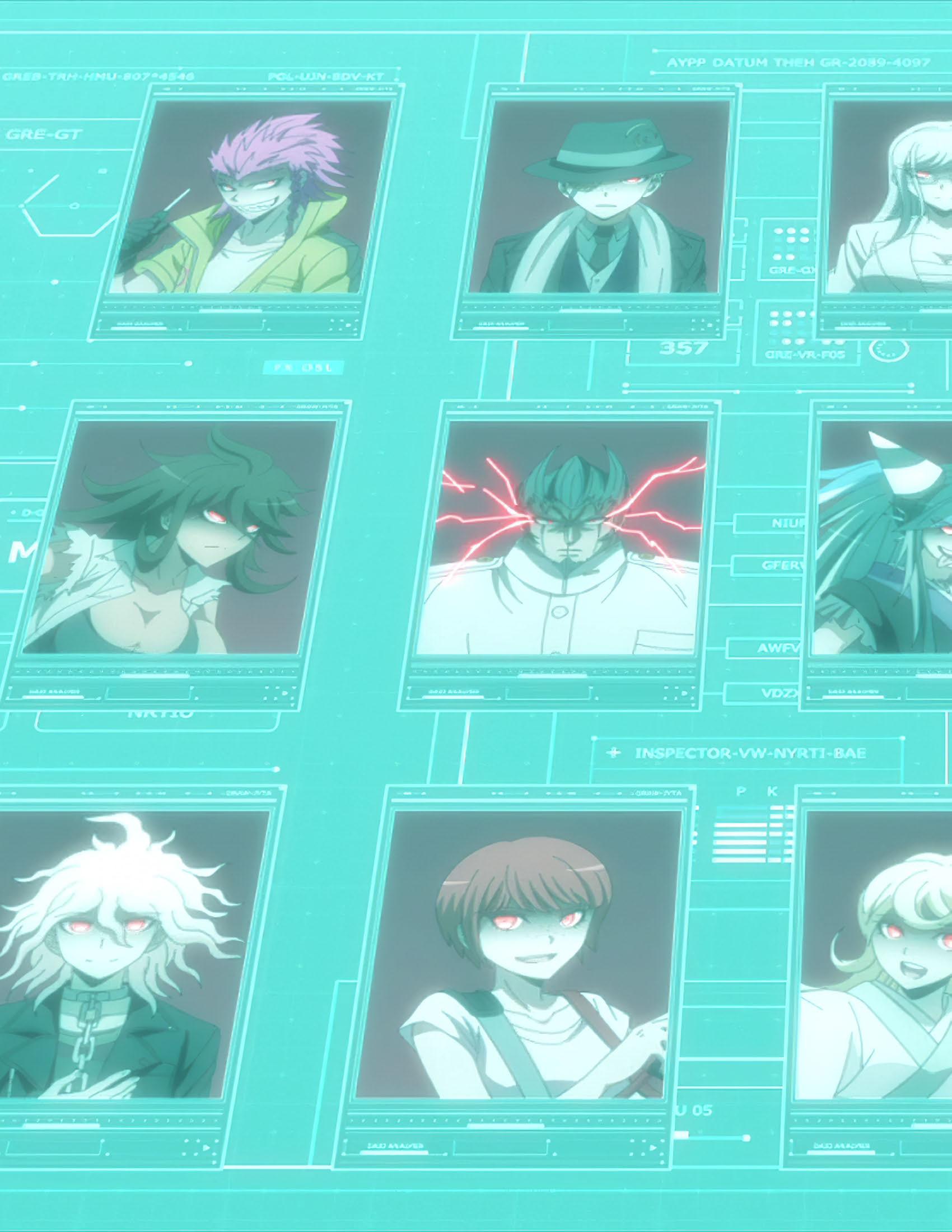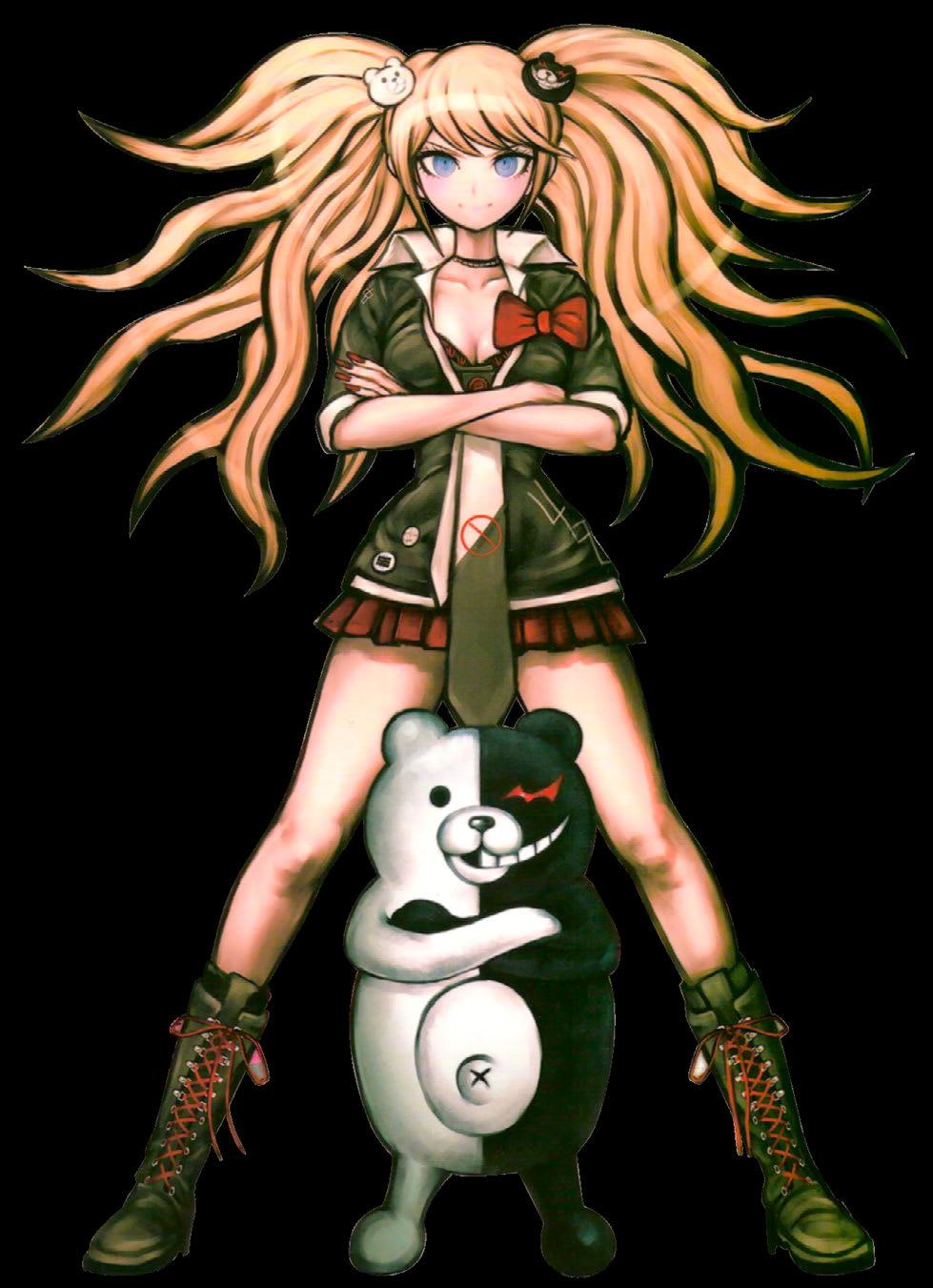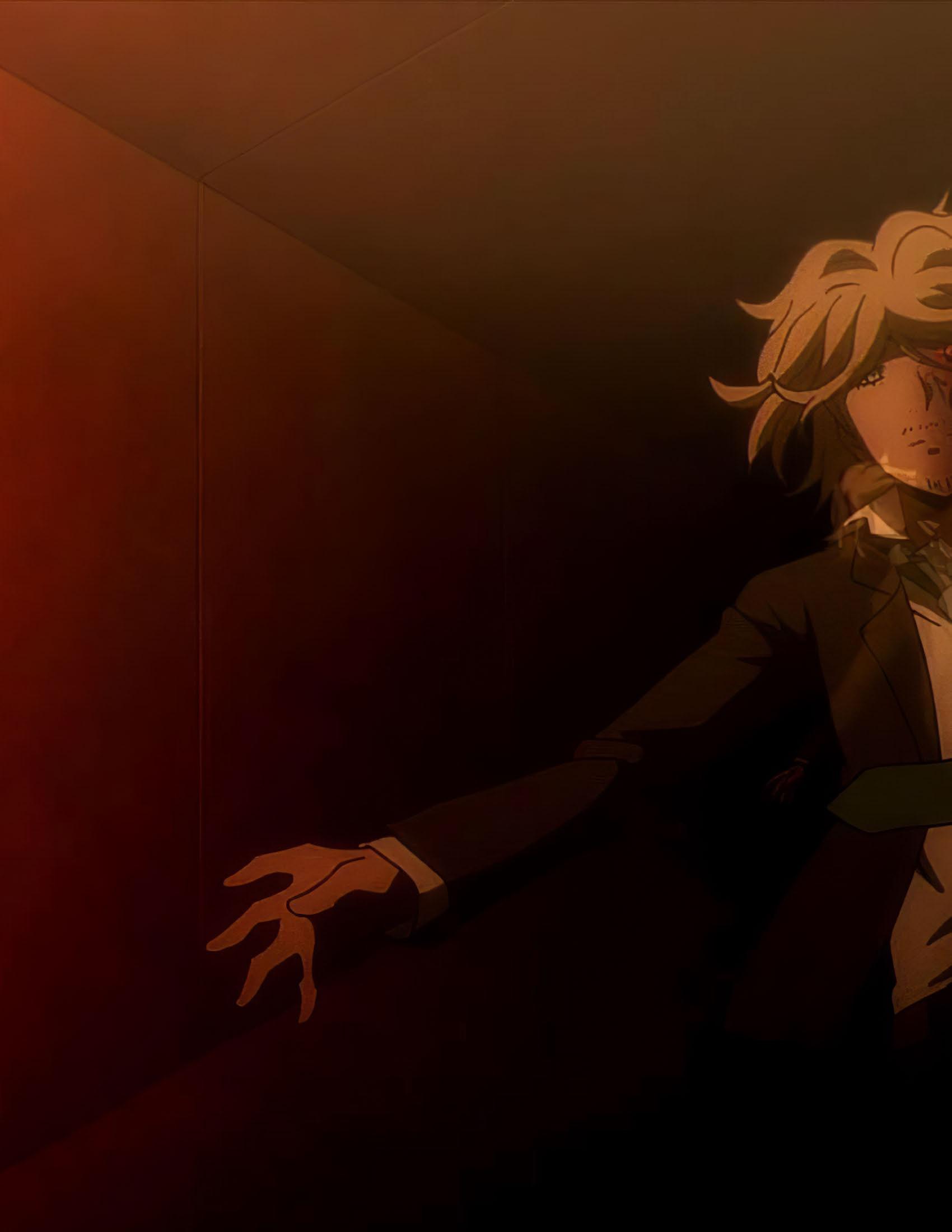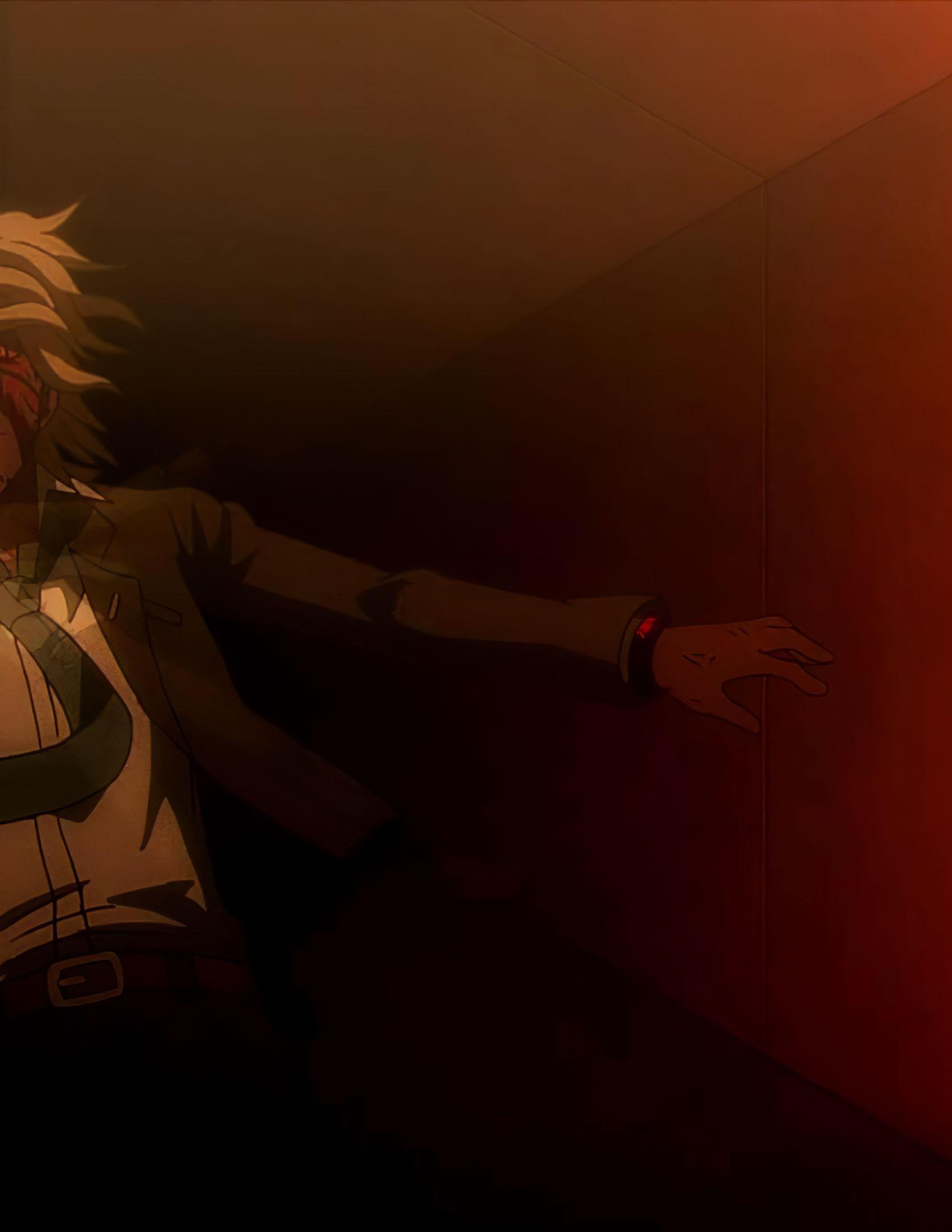
29 minute read
Danganronpa: Guilt, Propaganda, Asociality, and Despair in Anime


Advertisement







In the Danganronpa 3 anime, Former Hope’s Peak perial Japan and the cult of Aum Shinrikyō.
Academy Headmaster Kazuo Tengan masquerades as a Ryōta Mitarai really likes anime. He also thinks his
Remnant, in hopes of winning an ultimate victory for… life kind of sucks. Life disappoints him on the regular, well, Hope. He organizes a terrible new killing game, what with him having no friends. Anime perks his mood hoping it will make things so bad that it will convince up regularly, what with its perky stories. Anime’s his the Ultimate Animator to unleash his talents on the regular source of joy, his only source, in fact. He likes world. You might ask what’s so terrifying about an ani‐ watching anime so much so that he eventually decided mator, and the answer to that would be because it’s to try his hand at making some. He discovered he had
Danganronpa, at least in part. Ultimate Animator Ryōta a talent for it, and so he decided to go hardcore at it. has not only the capacity to make engaging and com‐ Thereafter, he spent most of his days inside, making pelling anime. His animator skills also give him the anime. Over the course of his self-imposed shut-in life, ability to outright brainwash and mind control people. he discovered his talent held actual, real power—not
In his quest to craft the ultimate anime capable of mov‐ only over himself, but also others. The anime he created ing everyone who watches it, Ryōta’s talents were manip‐ seemed to smooth out every disappointing and depress‐ulated by Junko to cause the apocalypse through mass ing wrinkle of his existence. His anime him believe that hypnosis mind control. Kazuo is now trying to utilize that he could do the same to every person that watched his talents to reverse it… by also using mass hypnosis his work. He resolved to create an anime whose story mind control. could touch everyone, an ultimate anime of Hope that
As an arguable, albeit unwilling, Remnant of Despair would compel his audiences to make the world a better himself, his skills have the power to change people for place. But instead of trying to inspire people to make the kinder and for the terrible. To be clear, while effec‐ the world better, his creations were more designed to tive propaganda can influence how people behave in coerce them.
Icertain situations, Danganronpa 3 is not an accurate example of how propaganda actually works. It over‐simplifies the power media consumption have at shap‐His abilities were not so much calling people to ac‐tion as they were controlling them to do what he wants. Like weapons of mass destruction (and mass hypnosis n Danganronpa, there is Despair and her Remnants. In addition to the Ultimate Despair Junko Enoshima of ing viewer psychology. Animation is a type of media, might technically be considered in DanganronpaDangaronpa 1, there are also the Remnants of Despair of as a and where influencing media consumers are concerned, the power animation has over how people think is con‐Danganronpa 2. In the class of ), those abilities are coercive, dangerous, and de‐humanizing. While what Ryōta wants may be entirely Danganronpa universe, the ditional. The show unrealistically imagines that it is pos‐ noble, those same powers, in the wrong hands, can fuelRemnants of Despair are Junko’s agents: sewing chaos, sible that media creators in its universe, the Ultimate far more ignoble ambitions. mayhem… mass Despair, generally. According to the
Animator specifically, can brainwash other people through a glass reflection’s glance if they’re “Ultimate” By really bad luck or utterly cruel fate, Junko bumps into Ryōta. After needling him into being allowed toDanganronpa lore, most killed themselves after learning enough. Despite what’s possible inJunko was defeated. Several managed on to justify living
Danganronpa and what’s actually pos‐sible in real life, the anime nonetheless got me thinking about real-life parallels. on, causing trouble for our heroes. Some of these Remnants genuinely believe in despair and worship
For me, Danganronpa 3 seemed to be Junko. Others were brainwashed or manipulated intosubtly drawing a connection between its Ultimate Ryōta and Japanese creatorsbecoming Remnants. The Ultimate Lucky Student and Hope such as cartoonists and animators. Will‐Fetishist Nagito Komaeda was persuaded by Junko to ingly and unwillingly, wittingly and un‐wittingly, these artists channeled their skills into creating propaganda for cer‐become a Remnant. Junko convinced that if Hope prevails at humanity’s darkest hour, he’ll experience his best… tain causes, like World War II-era Im‐release yet. All he has to pursue his agenda of hope is… help make things super dark for humanity. Nagito’s weird.Ryo ¯ta Mitarai watching anime on TV.



In the Danganronpa 3 anime, Former Hope’s Peak perial Japan and the cult of Aum Shinrikyō.
Academy Headmaster Kazuo Tengan masquerades as a Ryōta Mitarai really likes anime. He also thinks his
Remnant, in hopes of winning an ultimate victory for… life kind of sucks. Life disappoints him on the regular, well, Hope. He organizes a terrible new killing game, what with him having no friends. Anime perks his mood hoping it will make things so bad that it will convince up regularly, what with its perky stories. Anime’s his the Ultimate Animator to unleash his talents on the regular source of joy, his only source, in fact. He likes world. You might ask what’s so terrifying about an ani‐ watching anime so much so that he eventually decided mator, and the answer to that would be because it’s to try his hand at making some. He discovered he had
Danganronpa, at least in part. Ultimate Animator Ryōta a talent for it, and so he decided to go hardcore at it. has not only the capacity to make engaging and com‐ Thereafter, he spent most of his days inside, making pelling anime. His animator skills also give him the anime. Over the course of his self-imposed shut-in life, ability to outright brainwash and mind control people. he discovered his talent held actual, real power—not
In his quest to craft the ultimate anime capable of mov‐ only over himself, but also others. The anime he created ing everyone who watches it, Ryōta’s talents were manip‐ seemed to smooth out every disappointing and depress‐ulated by Junko to cause the apocalypse through mass ing wrinkle of his existence. His anime him believe that hypnosis mind control. Kazuo is now trying to utilize that he could do the same to every person that watched his talents to reverse it… by also using mass hypnosis his work. He resolved to create an anime whose story mind control. could touch everyone, an ultimate anime of Hope that
As an arguable, albeit unwilling, Remnant of Despair would compel his audiences to make the world a better himself, his skills have the power to change people for place. But instead of trying to inspire people to make the kinder and for the terrible. To be clear, while effec‐ the world better, his creations were more designed to tive propaganda can influence how people behave in coerce them.
Icertain situations, Danganronpa 3 is not an accurate example of how propaganda actually works. It over‐simplifies the power media consumption have at shap‐His abilities were not so much calling people to ac‐tion as they were controlling them to do what he wants. Like weapons of mass destruction (and mass hypnosis n Danganronpa, there is Despair and her Remnants. In addition to the Ultimate Despair Junko Enoshima of ing viewer psychology. Animation is a type of media, might technically be considered in DanganronpaDangaronpa 1, there are also the Remnants of Despair of as a and where influencing media consumers are concerned, the power animation has over how people think is con‐Danganronpa 2. In the class of ), those abilities are coercive, dangerous, and de‐humanizing. While what Ryōta wants may be entirely Danganronpa universe, the ditional. The show unrealistically imagines that it is pos‐ noble, those same powers, in the wrong hands, can fuelRemnants of Despair are Junko’s agents: sewing chaos, sible that media creators in its universe, the Ultimate far more ignoble ambitions. mayhem… mass Despair, generally. According to the
Animator specifically, can brainwash other people through a glass reflection’s glance if they’re “Ultimate” By really bad luck or utterly cruel fate, Junko bumps into Ryōta. After needling him into being allowed toDanganronpa lore, most killed themselves after learning enough. Despite what’s possible inJunko was defeated. Several managed on to justify living
Danganronpa and what’s actually pos‐sible in real life, the anime nonetheless got me thinking about real-life parallels. on, causing trouble for our heroes. Some of these Remnants genuinely believe in despair and worship
For me, Danganronpa 3 seemed to be Junko. Others were brainwashed or manipulated intosubtly drawing a connection between its Ultimate Ryōta and Japanese creatorsbecoming Remnants. The Ultimate Lucky Student and Hope such as cartoonists and animators. Will‐Fetishist Nagito Komaeda was persuaded by Junko to ingly and unwillingly, wittingly and un‐wittingly, these artists channeled their skills into creating propaganda for cer‐become a Remnant. Junko convinced that if Hope prevails at humanity’s darkest hour, he’ll experience his best… tain causes, like World War II-era Im‐release yet. All he has to pursue his agenda of hope is… help make things super dark for humanity. Nagito’s weird.Ryo ¯ta Mitarai watching anime on TV.






watch his masterpiece-in-progress, she gets him to ex‐ full knowledge that his actions may well bring about plain how much his opus magnum to-be relies on brain‐ the apocalypse (which they eventually do). With every‐washing techniques — and not the actual content of thing terrible done, Junko delivers the coup-de-désespoir his stories. The guy never gets out much after becom‐ to Ryōta: he’s absolutely 100% unambiguously complicit ing obsessed with anime, and the only thing he ever in her crime, or rather their crime. He may as well be a does is watch and make anime. Anime isn’t especially Remnant. Post-apocalypse, he still adamantly insists to that renowned for being a mature storytelling medium the survivors who find out about him that he was forced yet, at least compared to other mediums like literature into doing it, he had no choice. and even movies. Motivating others into kindness by Ryōta shares similar circumstances to some Japanese empathizing with them through fiction would require cartoonists and animators during WWII. Now, there actually understanding others so he knows what writ‐ were some who were ideologically and whole-heartedly ing is relatable, an understanding he sorely lacks. As chauvinistic from the start of their careers. However, someone who wouldn’t know the first thing about peo‐ many of them weren’t. Like Ryōta, some even champi‐ple because of his shut-in lifestyle, it makes sense that oned causes that chauvinistic nationalists opposed. The whatever storytelling chops he did possess would fall years roughly grouped under the reign of Emperor far short of carrying his ultimate anime through. As an Taishō, the early 1910s to the late 1920s, were known alternative, he focused on mind control triggers over as the years of Taishō Democracy. They were liberal Examples of WWII propogandaempathetic storytelling. If nothing else, Anime is at least digital signals. times, where Japanese society was open to social ex‐pression, democratic experimentation,
As ultimately expected, Junko and left-of-center activism, more sinks her claws into Ryōta so than ever. Many artists, ganda best works when the people who that media is for her own ends. She ers were convinced that it was Japan’s right to dominate cartoonists, and animators targeted to are both already receptive to those messages takes what was inherently and subjugate as its own bona fide imperialist power. counted themselves as and are being exposed to complementary influences — exploitative and potentially Finally, there were those that were afraid of what would leftist social critics — the constant exhortations, rituals, and information redangerous about the happen to them and their loved ones if they resisted. commenting on, cri‐affirming the Emperor’s godliness, the government’s creation process of At war’s end, the Nuremberg Trials established an in‐tiquing, sometimes justness, and Japan’s greatness. his ultimate anime of ternational legal precedent: excoriating leading The lively social criticism of Hope, and re-chan‐ that an admission of fearful‐public figures even Taishō yesteryear was asphyx‐nels these skills into “The motivations of those ness on by those complicit in as they entertained iated until finally, it ceased to squirm, ready to be completely Shōwa compliant. Some cre‐creating media that causes Despair. Ryōta ini‐tially believes they’re on the artists, cartoonists, and animators who ultimately crimes against humanity dur‐ing the war would not excuse them from receiving their their audiences with their work. That brief era of Taishō Democ‐ators fled the country rather same side, with Junko encouraging offered their skills to the racy justly knot-notched dues. “I came to an end as the Japanese than work under these con‐him to further had no choice” would not savepropaganda offices varied.”Imperial regime geared all aspects of so‐ditions. Others who refused develops his Junko Enishima them. While the Nuremberg ciety to support its war efforts in the Pa‐to work but didn’t manage to mind control‐ Trials were set up to officially cific theater. To ensure everyone was giv‐flee were incarcerated until death or war’s end. Still ling skills as he works on their product. and specifically prosecute the atrocities of leading Ger‐ing their all to supporting the war (and others were initially imprisoned and then released un‐Junko later reveals dramatically what man Nazis, the complicit artists, cartoonists, and ani‐not trying to sabotage it, intentionally der the condition they channel their craft toward what she’s actually been having Ryōta work mators who created propaganda for Imperial Japan faced or otherwise), leading Imperial Ja‐the government demanded them. And finally, there were on when the project seems to have their own punishment in the form of guilt at contribut‐panese government, military, and those that needed little coercion to motivate them to hit the point of no return, a means ing to the despair of their own devastated homeland. public figures “enrolled” the extol Japan’s war efforts as righteous. to incite mass murder and hyste‐ And after wallowing in the despair brought about in country’s artists, cartoonists, The motivations of those artists, cartoonists, and ria. Junko then forces Ryōta to part by his creative inputs, like many of these criminal and animators into national animators who ultimately offered their skills to the pro‐complete their work, on pain of and complicit artists, cartoonists, and animators postpatriotic unions. They “en‐paganda offices varied. Some thought that the West had revealing his complicity to the WWII, Ryōta vowed to redirect his craft to reverse the listed” the services of these oppressed Japan for far too long. Others saw Japan as an world of creating this most damage and atone for his crimes. Whether or not they unions for making propa‐Asian liberator against Western imperialism. Still oth‐awful and terrible thing, in produced propaganda for the war effort or not, many ganda. Media as propa‐









watch his masterpiece-in-progress, she gets him to ex‐ full knowledge that his actions may well bring about plain how much his opus magnum to-be relies on brain‐ the apocalypse (which they eventually do). With every‐washing techniques — and not the actual content of thing terrible done, Junko delivers the coup-de-désespoir his stories. The guy never gets out much after becom‐ to Ryōta: he’s absolutely 100% unambiguously complicit ing obsessed with anime, and the only thing he ever in her crime, or rather their crime. He may as well be a does is watch and make anime. Anime isn’t especially Remnant. Post-apocalypse, he still adamantly insists to that renowned for being a mature storytelling medium the survivors who find out about him that he was forced yet, at least compared to other mediums like literature into doing it, he had no choice. and even movies. Motivating others into kindness by Ryōta shares similar circumstances to some Japanese empathizing with them through fiction would require cartoonists and animators during WWII. Now, there actually understanding others so he knows what writ‐ were some who were ideologically and whole-heartedly ing is relatable, an understanding he sorely lacks. As chauvinistic from the start of their careers. However, someone who wouldn’t know the first thing about peo‐ many of them weren’t. Like Ryōta, some even champi‐ple because of his shut-in lifestyle, it makes sense that oned causes that chauvinistic nationalists opposed. The whatever storytelling chops he did possess would fall years roughly grouped under the reign of Emperor far short of carrying his ultimate anime through. As an Taishō, the early 1910s to the late 1920s, were known alternative, he focused on mind control triggers over as the years of Taishō Democracy. They were liberal Examples of WWII propogandaempathetic storytelling. If nothing else, Anime is at least digital signals. times, where Japanese society was open to social ex‐pression, democratic experimentation,
As ultimately expected, Junko and left-of-center activism, more sinks her claws into Ryōta so than ever. Many artists, ganda best works when the people who that media is for her own ends. She ers were convinced that it was Japan’s right to dominate cartoonists, and animators targeted to are both already receptive to those messages takes what was inherently and subjugate as its own bona fide imperialist power. counted themselves as and are being exposed to complementary influences — exploitative and potentially Finally, there were those that were afraid of what would leftist social critics — the constant exhortations, rituals, and information redangerous about the happen to them and their loved ones if they resisted. commenting on, cri‐affirming the Emperor’s godliness, the government’s creation process of At war’s end, the Nuremberg Trials established an in‐tiquing, sometimes justness, and Japan’s greatness. his ultimate anime of ternational legal precedent: excoriating leading The lively social criticism of Hope, and re-chan‐ that an admission of fearful‐public figures even Taishō yesteryear was asphyx‐nels these skills into “The motivations of those ness on by those complicit in as they entertained iated until finally, it ceased to squirm, ready to be completely Shōwa compliant. Some cre‐creating media that causes Despair. Ryōta ini‐tially believes they’re on the artists, cartoonists, and animators who ultimately crimes against humanity dur‐ing the war would not excuse them from receiving their their audiences with their work. That brief era of Taishō Democ‐ators fled the country rather same side, with Junko encouraging offered their skills to the racy justly knot-notched dues. “I came to an end as the Japanese than work under these con‐him to further had no choice” would not savepropaganda offices varied.”Imperial regime geared all aspects of so‐ditions. Others who refused develops his Junko Enishima them. While the Nuremberg ciety to support its war efforts in the Pa‐to work but didn’t manage to mind control‐ Trials were set up to officially cific theater. To ensure everyone was giv‐flee were incarcerated until death or war’s end. Still ling skills as he works on their product. and specifically prosecute the atrocities of leading Ger‐ing their all to supporting the war (and others were initially imprisoned and then released un‐Junko later reveals dramatically what man Nazis, the complicit artists, cartoonists, and ani‐not trying to sabotage it, intentionally der the condition they channel their craft toward what she’s actually been having Ryōta work mators who created propaganda for Imperial Japan faced or otherwise), leading Imperial Ja‐the government demanded them. And finally, there were on when the project seems to have their own punishment in the form of guilt at contribut‐panese government, military, and those that needed little coercion to motivate them to hit the point of no return, a means ing to the despair of their own devastated homeland. public figures “enrolled” the extol Japan’s war efforts as righteous. to incite mass murder and hyste‐ And after wallowing in the despair brought about in country’s artists, cartoonists, The motivations of those artists, cartoonists, and ria. Junko then forces Ryōta to part by his creative inputs, like many of these criminal and animators into national animators who ultimately offered their skills to the pro‐complete their work, on pain of and complicit artists, cartoonists, and animators postpatriotic unions. They “en‐paganda offices varied. Some thought that the West had revealing his complicity to the WWII, Ryōta vowed to redirect his craft to reverse the listed” the services of these oppressed Japan for far too long. Others saw Japan as an world of creating this most damage and atone for his crimes. Whether or not they unions for making propa‐Asian liberator against Western imperialism. Still oth‐awful and terrible thing, in produced propaganda for the war effort or not, many ganda. Media as propa‐







artists, cartoonists, and animators since have dedicated Remnants are anti-social, or hostile to others and soci‐her enemies in the Pacific War by whatever means, up their future work toward promoting pacifism in place ety at large. They rather cheerfully like bringing harming until that same Japan was firebombed and nuked into of militarism. Unlike them though, Ryōta traumatically and suffering to people and they did actively help bring ruin and Imperial regime submitted and was disman‐comes to a bad end conclusion with Danganronpa 3’s about the apocalypse. Ryōta is more asocial though, tled, whereupon a deep and scarring Despair took hold final killing game, the conclusion the killing mastermind distant from others and society at large. His kind of over the country’s survivors. For a more modern as well Tengan been counting on him falling into. In order to asociality is a combination of indifference and fear, an as concrete example of Hope bringing Despair though, reverse the Despair he’s complicit in causing with his extreme prioritization of his singular passion at the ex‐there’s Aum Shinrikyō. technology, and to make up for all his denial and inac‐ pense of his social-confidence. Like those asocial folks The ultimate Hope of Aum Shinrikyō’s many fol‐tion, he decides to use that that same technology elimi‐ picked up by Shoko Asahara and Aum Shinrikyō, that lowers is one that I doubt most people would take issue nate Despair once and for all. People can’t cause Despair seclusion from robust, healthy, or just any social support with in the abstract, even if they think it’s a bit naive: a to each other if they don’t have the agency to cause, af‐ network made Ryōta all that more easy a mark for Junkoutopia, a world free from conflict. However, the means ter all. With this act, Ryōta the effective criminal Rem‐ to manipulate into contributing to her cult of Despair. that Aum Shinrikyō used to live up to this Hope de‐nant can achieve a total victory for Hope, or so he comes Ryōta hoped to use his animation talents to make the manded a lot of violence, that violence culminating into to believe. world at least a little better. Instead, his talents were ap‐13 people killed and many others maimed in the 1995
Both Ryōta’s complicity in using brainwashing to propriated by Junko to make the world so much worse. Tōkyō Sarin Gas Attacks. Aum Shinrikyō has been propagate Despair and Ryōta’s desperation to use brain- As aforementioned, the killing game leads him to that described by news media pundits and religious studies voked the trope of evil cults in their narratives. Part of washing to propagate Hope are but additional complex‐ conclusion that Tengan hopes he scholars as a type of cult. The definition surrounding the anime industry’s obsession with cults has to do with ities added by the creator of Danganronpa to his fran‐ would come to: defeating the the word “cult” is a matter of debate both within and it leaving a scar in Japan’s larger cultural psyche. Part of chise’s initial moral binary of Hope vs Despair. In some Despair that leads to killing outside academic circles. Cult in at least the malicious it also stems from the role that animators played in pro‐ways, Hope and Despair is like oil and water — mutu‐ games by removing the poten‐sense is characterized by a fanatical single-mindedness ducing for Aum Shinrikyō. Counted within the ranks of ally exclusive, seemingly, but found together quite often tial for Despair to even be a toward something, like an idol or a goal. cult members within Aum Shinrikyō were artists, car‐in soup broth and salad dressing as part of flavor com‐ thought. By projecting control The cult members of Aum Shinrikyō followed its idol, toonists, and animators charged with using their skills toplements. Hope can lead to Despair, and terrible De‐ over everyone’s minds — over‐Shoko Asahara, and subordinated their thoughts to his. create art, manga, and anime featuring messages tailored spair at that, the whole “the road to hell” dynamic. Among riding their free will, the basis They did so under the promise that he would bring about toward the recruitment of more cult members. other tools, the Imperial regime used art, cartoons, and of their humanity — Hope will this utopia mentioned earlier. Since the 1995 Tōkyō With many cult members before and especially after anime to paint the Hope Japan that would prevail over triumph. Irony and hypocrisy Sarin Gas Attack, anime franchises have repeatedly in‐the 1995 Tōkyō Sarin Gas Attacks being characterized notwithstanding, there will as various forms of asocial and anti-social, and anime be utopia. The Aum Shinrukyo cult (left) and their leader, Shoko Asahara (right), whose name otaku being largely seen as anti-social or asocial due To all our major char‐is not widely known in the West. Subway sarin gas attack scene (next page). to their shut-in NEET association and the Miyazaki acters besides the Ulti‐Tsutomu serial murders of the late 1980s, anime and mate Animator, this other aspects of the otaku subculture were ultimately ultimate solution is a connected in the public discourse with anti-social and dystopic non-option. asocial tendencies. The fact that some Aum Shinrikyō Makoto Naegi, Hajime cult members were cartoonists or animators didn’t help Hinata, and Kyosuke the reputation of anime fans. Some viciously resented Munakata end up enduring other people and society because of bad experiences with similar, if not worse, trauma at both, and joined Aum Shinrikyō because the cult ac‐ Junko’s hands. But even through knowledged and encouraged that anti-social resentment. that Despair, they endured. Be‐Others simple felt isolated by a society and people at cause the loves they felt and the large that didn’t fully understand and accept them, and friendships they made were only joined Aum Shinrikyō because it offered a place they possible with them, they fought felt comfortable belonging to. back for humanity’s right for their
Despair’s Remnants are effectively a cult (or the in‐ own minds ner circle of a cult). With some idiosyncrasies between members like Nagito, they hold a fanatical single-minded Ryo ¯ta Mitarai devotion to Junko and Despair. The majority of the





artists, cartoonists, and animators since have dedicated Remnants are anti-social, or hostile to others and soci‐her enemies in the Pacific War by whatever means, up their future work toward promoting pacifism in place ety at large. They rather cheerfully like bringing harming until that same Japan was firebombed and nuked into of militarism. Unlike them though, Ryōta traumatically and suffering to people and they did actively help bring ruin and Imperial regime submitted and was disman‐comes to a bad end conclusion with Danganronpa 3’s about the apocalypse. Ryōta is more asocial though, tled, whereupon a deep and scarring Despair took hold final killing game, the conclusion the killing mastermind distant from others and society at large. His kind of over the country’s survivors. For a more modern as well Tengan been counting on him falling into. In order to asociality is a combination of indifference and fear, an as concrete example of Hope bringing Despair though, reverse the Despair he’s complicit in causing with his extreme prioritization of his singular passion at the ex‐there’s Aum Shinrikyō. technology, and to make up for all his denial and inac‐ pense of his social-confidence. Like those asocial folks The ultimate Hope of Aum Shinrikyō’s many fol‐tion, he decides to use that that same technology elimi‐ picked up by Shoko Asahara and Aum Shinrikyō, that lowers is one that I doubt most people would take issue nate Despair once and for all. People can’t cause Despair seclusion from robust, healthy, or just any social support with in the abstract, even if they think it’s a bit naive: a to each other if they don’t have the agency to cause, af‐ network made Ryōta all that more easy a mark for Junkoutopia, a world free from conflict. However, the means ter all. With this act, Ryōta the effective criminal Rem‐ to manipulate into contributing to her cult of Despair. that Aum Shinrikyō used to live up to this Hope de‐nant can achieve a total victory for Hope, or so he comes Ryōta hoped to use his animation talents to make the manded a lot of violence, that violence culminating into to believe. world at least a little better. Instead, his talents were ap‐13 people killed and many others maimed in the 1995
Both Ryōta’s complicity in using brainwashing to propriated by Junko to make the world so much worse. Tōkyō Sarin Gas Attacks. Aum Shinrikyō has been propagate Despair and Ryōta’s desperation to use brain- As aforementioned, the killing game leads him to that described by news media pundits and religious studies voked the trope of evil cults in their narratives. Part of washing to propagate Hope are but additional complex‐ conclusion that Tengan hopes he scholars as a type of cult. The definition surrounding the anime industry’s obsession with cults has to do with ities added by the creator of Danganronpa to his fran‐ would come to: defeating the the word “cult” is a matter of debate both within and it leaving a scar in Japan’s larger cultural psyche. Part of chise’s initial moral binary of Hope vs Despair. In some Despair that leads to killing outside academic circles. Cult in at least the malicious it also stems from the role that animators played in pro‐ways, Hope and Despair is like oil and water — mutu‐ games by removing the poten‐sense is characterized by a fanatical single-mindedness ducing for Aum Shinrikyō. Counted within the ranks of ally exclusive, seemingly, but found together quite often tial for Despair to even be a toward something, like an idol or a goal. cult members within Aum Shinrikyō were artists, car‐in soup broth and salad dressing as part of flavor com‐ thought. By projecting control The cult members of Aum Shinrikyō followed its idol, toonists, and animators charged with using their skills toplements. Hope can lead to Despair, and terrible De‐ over everyone’s minds — over‐Shoko Asahara, and subordinated their thoughts to his. create art, manga, and anime featuring messages tailored spair at that, the whole “the road to hell” dynamic. Among riding their free will, the basis They did so under the promise that he would bring about toward the recruitment of more cult members. other tools, the Imperial regime used art, cartoons, and of their humanity — Hope will this utopia mentioned earlier. Since the 1995 Tōkyō With many cult members before and especially after anime to paint the Hope Japan that would prevail over triumph. Irony and hypocrisy Sarin Gas Attack, anime franchises have repeatedly in‐the 1995 Tōkyō Sarin Gas Attacks being characterized notwithstanding, there will as various forms of asocial and anti-social, and anime be utopia. The Aum Shinrukyo cult (left) and their leader, Shoko Asahara (right), whose name otaku being largely seen as anti-social or asocial due To all our major char‐is not widely known in the West. Subway sarin gas attack scene (next page). to their shut-in NEET association and the Miyazaki acters besides the Ulti‐Tsutomu serial murders of the late 1980s, anime and mate Animator, this other aspects of the otaku subculture were ultimately ultimate solution is a connected in the public discourse with anti-social and dystopic non-option. asocial tendencies. The fact that some Aum Shinrikyō Makoto Naegi, Hajime cult members were cartoonists or animators didn’t help Hinata, and Kyosuke the reputation of anime fans. Some viciously resented Munakata end up enduring other people and society because of bad experiences with similar, if not worse, trauma at both, and joined Aum Shinrikyō because the cult ac‐ Junko’s hands. But even through knowledged and encouraged that anti-social resentment. that Despair, they endured. Be‐Others simple felt isolated by a society and people at cause the loves they felt and the large that didn’t fully understand and accept them, and friendships they made were only joined Aum Shinrikyō because it offered a place they possible with them, they fought felt comfortable belonging to. back for humanity’s right for their
Despair’s Remnants are effectively a cult (or the in‐ own minds ner circle of a cult). With some idiosyncrasies between members like Nagito, they hold a fanatical single-minded Ryo ¯ta Mitarai devotion to Junko and Despair. The majority of the








